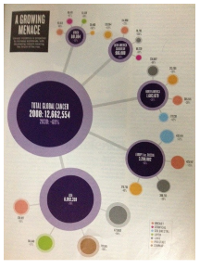The ‘Cancer Villages’ in China: Toxicological Pathways And Susceptibility To Replication in Nigeria
Keywords:
Cancer villages, Cadmium pollution, DNA damage repair, Chemoprevention, NigeriaAbstract
The recent observation of the existence of ‘cancer villages’ in China appears a precise confirmation of the prediction of Rachel Carson over five decades ago; that ‘one in every four’ will develop cancer, a consequence of indiscriminate chemical application . The observation also appears an exquisite confirmation of recent reports that though the incidence of cancer is projected to increase globally, the developing nations will bear the brunt. The possible susceptibility to replication of the China ‘cancer villages’ in Nigeria despite obvious precursors has received little attention. China is perhaps the world’s most polluted country currently owing to the fast pace of industrialization and has openly admitted that toxic chemicals have caused many environmental emergencies, including elevated cancer rates. The toxicological pathways though glaring have been ignored for years. China is one of the countries with the highest emission of cadmium (Cd); a prime and ubiquitous environmental pollutant which contributes to genome instability, precursor of the carcinogenic process through a number of pathways; direct damage to DNA and inhibition of DNA repair mechanisms as well as interference with signal transduction pathways among others. Additionally, Cd is a potent metabolic antagonist of zinc, an important component of p53 (‘guardian of the genome’), regulator of the cell cycle and zinc fingers. Aside, from Cd, China currently uses enormous amount of other chemicals and physical agents; profusion of petrochemicals, existence of numerous steel and iron refineries, numerous power plants to drive her giant industries, a situation similar to that in Nigeria. Therefore, rather than be preoccupied with weight of evidence, Nigeria should thread the path of cautionary principle to avert the emergence of mega ‘cancer villages’
Downloads
References
Aggarwal, B.B. (2004) Nuclear factor-kB: the enemy within. Cancer Cell 6: 203-208.
Aggarwal, B.B., Shishodia, S., Sandur, S.K, Pandey, M.K., Sethi, G. (2006). Inflammation and cancer: how hot is the link? Biochem. Pharmacol. 72: 1605-1621.
Colotta, F., Allavena, P., Ica, A, A.,Garlanda, C., Mantovani, A. (2009) Cancer-related inflammation, seveth hallmark of cancer: links to genetic instability. Carcinogenesis 30: 1073-1081.
Ames, B. N. (2010). Prevention of mutation, cancer and other age- associated disease by optimizing micronutrient intakes. J. Nucleic Acids Volume 2010, Article ID 725071, 11 pages. Doi: 40612010/725071
ATSDR (Agency for Toxic Substance and Disease Registry) (2005). Toxicological profile for Cadmium. Atlanta, GA…..
Ames, B.N., McCann, J.M. (2009) Forward: Prevention of Cancer and other Degenerative Diseases of Aging, Through Nutrition In: Chemoprevention of Cancer and DNA Damage by Dietary Factors. Knasmuller S et al. (eds.) Wiley- VCH GmbH & Co Germany. Xxx- xxxviii.
Anetor J. I. (2012) Rising environmental cadmium levels in developing countries: threat to genome stability and health. Niger J. Physiol. Sci. 27: 103- 115.
Anetor JI et al. 2009. Mixed chemical- induced oxidative stress in occupational exposure in Nigerians. Afr. J. Biotech. 8: 821- 826.
Bertin, G., Averbeck, P. (2006). Cadmium: cellular effects, modification of biomolecules, modulation of DNA repair and genotoxic consequences. Biochimie 88(11) 1549- 1559
Boyle P., Levin B. (eds.) World Cancer Reports 2008
Boseley, S (2014). Global cancer surge fuelled by alcohol, smoking and obesity predicted by WHO. The Guardian, Monday, February.
Carson, R.L. (2002). Silent Spring. Mariner Books, New York
Dear J. W. (2013) Poisoning. In: Marshall, W. J., Lapsley, M., Day, A. P., Ayling, R. M. (eds.). Clinical Biochemistry: Metabolic and Clinical Aspects. Churchill Livingstone-Elsevier, Edinburgh, pp. 787- 807.
Fenech, M. (2002) Micronutrients and genomic stability: a new paradigm for recommended dietary allowances (RDAs). Food Chem. Toxicol. 40: 1113-1117
Fenech, M. (2004) Genome health nutrigenomics: nutrition and the science of optimum genome maintenance. Asia Pac. J. Clin. Nutr. 13: (suppl.) S15,
Ho, E., courtemanche, C., Ames, B.N. (2003). Zinc deficiency induces oxidative DNA damage and increases p53 expression in human lung fibroblasts. J. Nutr. 133: 2543-2548.
Jemal, A., Bray, F., Center, M. M., Ferlay, J., Ward, E., Forman, D. (2011) Global cancer statistics, 2011. CA Cancer J. Clin. 61: 69-90.
Joseph, P. (2009). Mechanisms of cadmium carcinogenesis. Tox. Appl. Pharmacol. 238: 272-279.
Kwong T. C., magnanni, B, Rosano, T. G, Shaw, L.M. (eds.) (2013) The Clinical Toxicology Laboratory: Contemporary Practice of Poisoning Evaluation. AACC Press, pp 344- 348.
Kundu, J. K., Surh, Y-J (2008) Inflammation: gearing the journey to cancer. Mutat. Res. 659: 15 – 30.
Lane, D.P. (1992). P53, guardian of the genome. Nature. 358: 15-16.
Liu, J., Qu, W., Kadiiska, M.B. (2009). Role of oxidative stress in cadmium toxicity and carcinogenesis. Tox. Appl. Pharmacol. 238: 209- 214.
Mantovani, A., Allavena, P., Sica, A.,and Balkwill F. (2008) Cancer –related inflammation. Nature. 454: 436-444.
Nordberg,G. F., Nogawa, K., Nordberg, M., Friberg, L.T. (2007). Cadmium. In: Nordberg, G.F., Fowler, B.A.,Nordberg, M., Friberg, L.T., (Eds), Handbook on the Toxicology of Metals. Third edition, Academic Press, pp446-486.
Nordberg, G. F. (2009). Historical perspectives on cadmium toxicology. Tox. Appl. Pharmacol. 238: 192-200.
O’Callaghan T. 2011. The prevention agenda. Nature. 4771: S2-S4
Pecorino, L. (2012) Molecular Biology of Cancer: Mechanisms, Targets and Therapy. Oxford, third edition.pp1-5, 21-51, 123-127, 253-270.
Ragnathan N et al., (2010) Cadmium alters the biotransformation of carcinogenic aromatic amines by arylamine, N-acetyltransferase xenobiotic metabolising enzymes: molecular, cellular & in vivo studies. Environ. Health Perspect. 118: 1685-1691.
Satarug S, Baker JR, Urbengjapol et al. 2003. A global perspective on cadmium pollution and toxicity in non-occupationally exposed population . Toxicol. Lett. 137: 65-83. Statistics, 2011. CA Cancer J. Clin. 61: 212-236.
Siegel, R., Ward, E., Brawley, O., Jemal, A. (2011) Cancer Science, 29 August 2008, p.1155, Science 1st March, 2013,p1018.
Sun LN, Zhang YH, Sun, T. H. et al. (2006). Temporal spartial distribution and contamination in soils in Shenyang, Zhangshi irrigation area China. J Environ Sci. (China) 18: 1241- 1246.
Thevenod, F. (2009). Cadmium and cellular signalling cascades: to be or not to be. Tox. Appl. Pharmacol. 238: 221-239.
Tomatis, L., Huff, J. (2001) . Evolution of cancer and primary prevention. Environ. Health Perspect. 109 : A458- A460.
True, B-L., Dreisbach, R. H. (2002) . Dreisbach’s Handbook of Poisoning: Prevention, Diagnosis and Treatment. Thirteenth Edition, Boca Raton, p.13.
UNEP (United Nations Environment Program) (2012). Global Chemicals Outlook: Towards Sound Management of Chemicals. ISBN: 978-92-807- 3275-7
Winston R. 2010. Bad Ideas? An Arresting History of Our Inventions. Transworld Publishers, Uxbridge, London, pp 312-317.
Yan S, Ling QC, Bao ZY. 2007. Metal contamination in soils and vegetable in metal smelter contaminated sites in Huangshi; China. Bull. Environ. Contam. Toxicol. 79: 361- 366.

Downloads
Published
Issue
Section
License

This work is licensed under a Creative Commons Attribution-NonCommercial-ShareAlike 4.0 International License.







